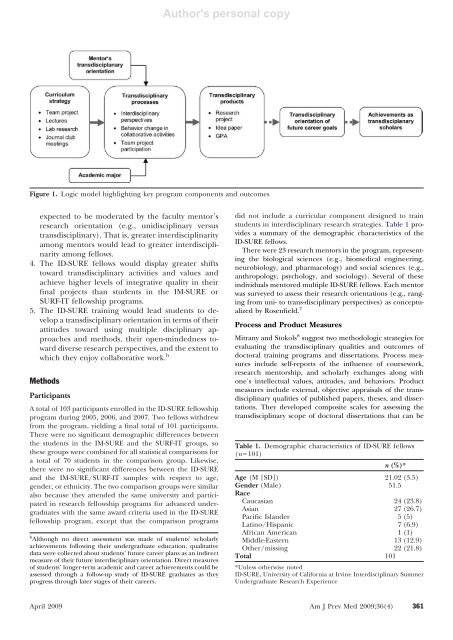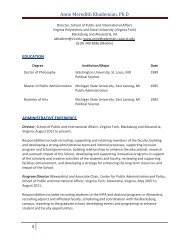Evaluating an interdisciplinary undergraduate training program in ...
Evaluating an interdisciplinary undergraduate training program in ...
Evaluating an interdisciplinary undergraduate training program in ...
You also want an ePaper? Increase the reach of your titles
YUMPU automatically turns print PDFs into web optimized ePapers that Google loves.
Author's personal copy<br />
Figure 1. Logic model highlight<strong>in</strong>g key <strong>program</strong> components <strong>an</strong>d outcomes<br />
expected to be moderated by the faculty mentor’s<br />
research orientation (e.g., unidiscipl<strong>in</strong>ary versus<br />
tr<strong>an</strong>sdiscipl<strong>in</strong>ary). That is, greater <strong>in</strong>terdiscipl<strong>in</strong>arity<br />
among mentors would lead to greater <strong>in</strong>terdiscipl<strong>in</strong>arity<br />
among fellows.<br />
4. The ID-SURE fellows would display greater shifts<br />
toward tr<strong>an</strong>sdiscipl<strong>in</strong>ary activities <strong>an</strong>d values <strong>an</strong>d<br />
achieve higher levels of <strong>in</strong>tegrative quality <strong>in</strong> their<br />
f<strong>in</strong>al projects th<strong>an</strong> students <strong>in</strong> the IM-SURE or<br />
SURF-IT fellowship <strong>program</strong>s.<br />
5. The ID-SURE <strong>tra<strong>in</strong><strong>in</strong>g</strong> would lead students to develop<br />
a tr<strong>an</strong>sdiscipl<strong>in</strong>ary orientation <strong>in</strong> terms of their<br />
attitudes toward us<strong>in</strong>g multiple discipl<strong>in</strong>ary approaches<br />
<strong>an</strong>d methods, their open-m<strong>in</strong>dedness toward<br />
diverse research perspectives, <strong>an</strong>d the extent to<br />
which they enjoy collaborative work. b<br />
Methods<br />
Particip<strong>an</strong>ts<br />
A total of 103 particip<strong>an</strong>ts enrolled <strong>in</strong> the ID-SURE fellowship<br />
<strong>program</strong> dur<strong>in</strong>g 2005, 2006, <strong>an</strong>d 2007. Two fellows withdrew<br />
from the <strong>program</strong>, yield<strong>in</strong>g a f<strong>in</strong>al total of 101 particip<strong>an</strong>ts.<br />
There were no signific<strong>an</strong>t demographic differences between<br />
the students <strong>in</strong> the IM-SURE <strong>an</strong>d the SURF-IT groups, so<br />
these groups were comb<strong>in</strong>ed for all statistical comparisons for<br />
a total of 70 students <strong>in</strong> the comparison group. Likewise,<br />
there were no signific<strong>an</strong>t differences between the ID-SURE<br />
<strong>an</strong>d the IM-SURE/SURF-IT samples with respect to age,<br />
gender, or ethnicity. The two comparison groups were similar<br />
also because they attended the same university <strong>an</strong>d participated<br />
<strong>in</strong> research fellowship <strong>program</strong>s for adv<strong>an</strong>ced <strong>undergraduate</strong>s<br />
with the same award criteria used <strong>in</strong> the ID-SURE<br />
fellowship <strong>program</strong>, except that the comparison <strong>program</strong>s<br />
b Although no direct assessment was made of students’ scholarly<br />
achievements follow<strong>in</strong>g their <strong>undergraduate</strong> education, qualitative<br />
data were collected about students’ future career pl<strong>an</strong>s as <strong>an</strong> <strong>in</strong>direct<br />
measure of their future <strong><strong>in</strong>terdiscipl<strong>in</strong>ary</strong> orientation. Direct measures<br />
of students’ longer-term academic <strong>an</strong>d career achievements could be<br />
assessed through a follow-up study of ID-SURE graduates as they<br />
progress through later stages of their careers.<br />
did not <strong>in</strong>clude a curricular component designed to tra<strong>in</strong><br />
students <strong>in</strong> <strong><strong>in</strong>terdiscipl<strong>in</strong>ary</strong> research strategies. Table 1 provides<br />
a summary of the demographic characteristics of the<br />
ID-SURE fellows.<br />
There were 23 research mentors <strong>in</strong> the <strong>program</strong>, represent<strong>in</strong>g<br />
the biological sciences (e.g., biomedical eng<strong>in</strong>eer<strong>in</strong>g,<br />
neurobiology, <strong>an</strong>d pharmacology) <strong>an</strong>d social sciences (e.g.,<br />
<strong>an</strong>thropology, psychology, <strong>an</strong>d sociology). Several of these<br />
<strong>in</strong>dividuals mentored multiple ID-SURE fellows. Each mentor<br />
was surveyed to assess their research orientations (e.g., r<strong>an</strong>g<strong>in</strong>g<br />
from uni- to tr<strong>an</strong>s-discipl<strong>in</strong>ary perspectives) as conceptualized<br />
by Rosenfield. 7<br />
Process <strong>an</strong>d Product Measures<br />
Mitr<strong>an</strong>y <strong>an</strong>d Stokols 8 suggest two methodologic strategies for<br />
evaluat<strong>in</strong>g the tr<strong>an</strong>sdiscipl<strong>in</strong>ary qualities <strong>an</strong>d outcomes of<br />
doctoral <strong>tra<strong>in</strong><strong>in</strong>g</strong> <strong>program</strong>s <strong>an</strong>d dissertations. Process measures<br />
<strong>in</strong>clude self-reports of the <strong>in</strong>fluence of coursework,<br />
research mentorship, <strong>an</strong>d scholarly exch<strong>an</strong>ges along with<br />
one’s <strong>in</strong>tellectual values, attitudes, <strong>an</strong>d behaviors. Product<br />
measures <strong>in</strong>clude external, objective appraisals of the tr<strong>an</strong>sdiscipl<strong>in</strong>ary<br />
qualities of published papers, theses, <strong>an</strong>d dissertations.<br />
They developed composite scales for assess<strong>in</strong>g the<br />
tr<strong>an</strong>sdiscipl<strong>in</strong>ary scope of doctoral dissertations that c<strong>an</strong> be<br />
Table 1. Demographic characteristics of ID-SURE fellows<br />
(n101)<br />
n (%)*<br />
Age (M [SD]) 21.02 (3.5)<br />
Gender (Male) 51.5<br />
Race<br />
Caucasi<strong>an</strong> 24 (23.8)<br />
Asi<strong>an</strong> 27 (26.7)<br />
Pacific Isl<strong>an</strong>der 5 (5)<br />
Lat<strong>in</strong>o/Hisp<strong>an</strong>ic 7 (6.9)<br />
Afric<strong>an</strong> Americ<strong>an</strong> 1 (1)<br />
Middle-Eastern 13 (12.9)<br />
Other/miss<strong>in</strong>g 22 (21.8)<br />
Total 101<br />
*Unless otherwise noted<br />
ID-SURE, University of California at Irv<strong>in</strong>e Interdiscipl<strong>in</strong>ary Summer<br />
Undergraduate Research Experience<br />
April 2009 Am J Prev Med 2009;36(4) 361





